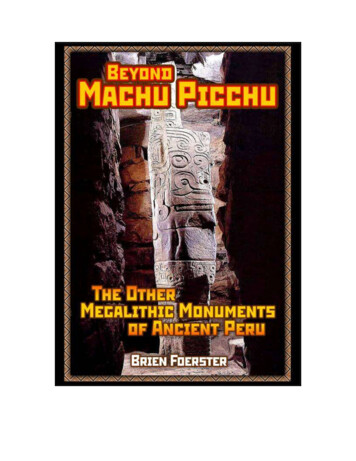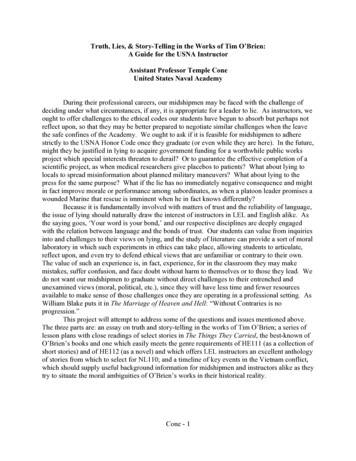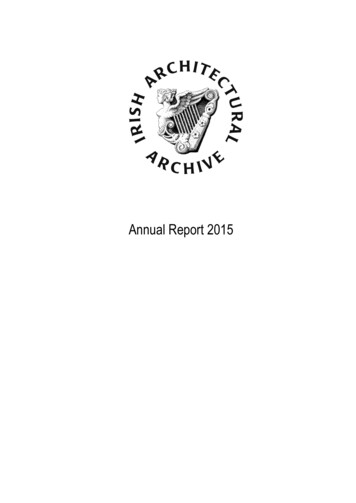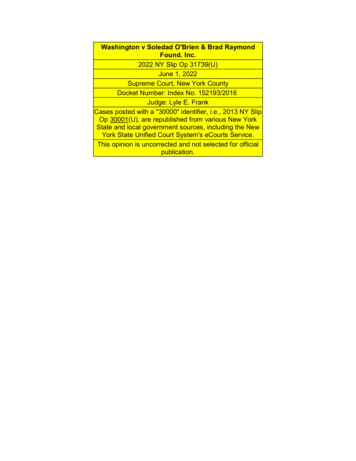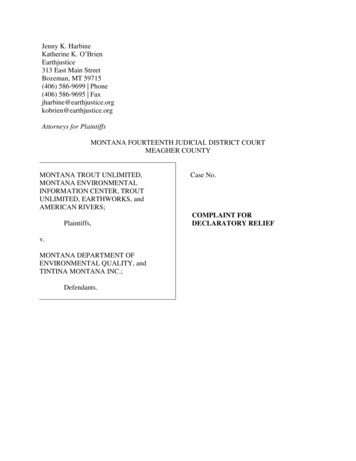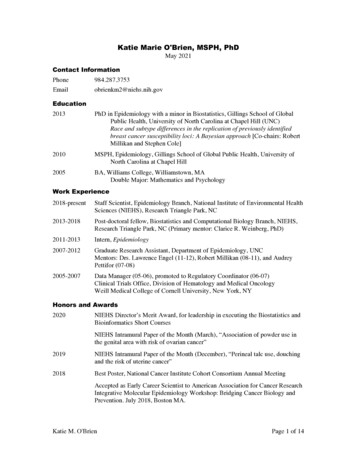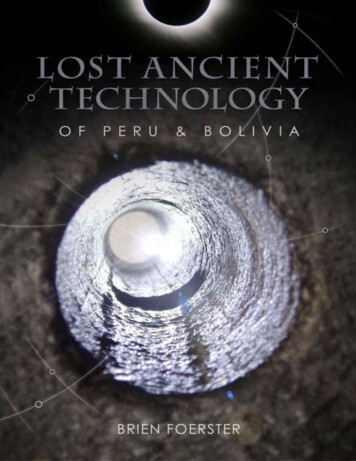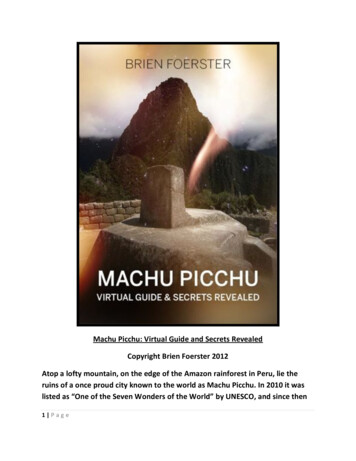
Transcription
Machu Picchu: Virtual Guide and Secrets RevealedCopyright Brien Foerster 2012Atop a lofty mountain, on the edge of the Amazon rainforest in Peru, lie theruins of a once proud city known to the world as Machu Picchu. In 2010 it waslisted as “One of the Seven Wonders of the World” by UNESCO, and since then1 P ag e
its fame and popularity have increased even further than before. On average,2000 people per day, 365 days a year visit this place, drawn by it’s exoticlocation, and the fact that it is reported as being the only Inca site of any sizethat the Spanish, under the conquistador Francisco Pizarro, never found, andthus never plundered for it’s gold.But what is the real story of this place? Who built it, when, why, and whatexplains its popularity to visitors from all over the world? To answer this, wemust, as an honest gesture, balance our inquiry. Most so-called “ruins” ofancient cultures, and the term “ruin” seems to automatically put into the mindof the reader abandoned structures with crumbling stone walls, are the domainof study by university trained academics; archaeologists and anthropologists.They tend to analyze what the inhabitants left behind; pot shards, fire pits,writings (if any) and the buildings, etc.What they tend not to do is ask the descendants of the “lost people,” the natureof who the ancestors were, and accounts of their origins, accomplishments, andreasons for their demise. By adding both of these types of exploration together,the reader may achieve what may well be a much fuller understanding of, in thiscase Machu Picchu and the Inca people who built it, than they would from apurely western scientific approach, or one based solely on oral traditions. Andbelieve me, the latter is much more difficult to obtain than the former, in mostcases.For some reason, and I frankly call it cultural arrogance many if not mostwestern academics and writers never consult Indigenous people in regards tothe constructions and people of the past. For example, the Mayan calendar, andthe year 2012. Millions of dollars have been made by many writers on thissubject, and the most common theme, as well as outcome of their treatise isthat the world ends on December 21, 2012, in a series of natural as well asperhaps human made disasters. But what do the oral traditions of the Mayathemselves say on the subject? The wisdom keepers of the traditions whom Ihave heard or spoken to say the same thing; a world ends on that date; not THE2 P ag e
world, but “a world,” which is a term they use for an age, a period of time. Andwhat happens after that? A new “world” or age begins.Anyway, I have strayed off our main topic, but did so in order that we start thisstudy and description of Machu Picchu knowing that I plan to give you as fullybalanced a story as possible. So let us start with the Inca themselves, themakers of Machu Picchu. Who were they, and where did they come from?The oral traditions vary to some degree, as does the archaeological evidence.But, the general belief is that the Inca are from the area, to the south, at or nearLake Titicaca. The most common story is that the Inca “rose from Lake Titicaca,summoned by their creator God Viracocha; who was the energy behind thecreation of all things. The sun is often written of as having been this main deity,but in fact the sun, known as Inti in the Runa simi or Quechua language, wasmore likely the physical manifestation of Viracocha. Inti was thus a symbol, inreal life, that the Inca could observe on a daily basis, much like, perhaps, thecross is a physical symbol of Jesus.The two founding Inca were Manco Capac, and his sister and wife, Mama Ocllo.They were told by their creator Viracocha to leave the area of Lake Titicaca andfound a new civilization.3 P ag e
Fanciful portrayal of Manco Capac and Mama OccloThe two most probable candidates for the homeland of the Inca, near LakeTiticaca, are the Island of the Sun, located in the lake, and presently part ofBolivia, or Tiwanaku (Tiahuanaco) which is approximately 11 miles south of thelake. I have been to the Island of the Sun, and was frankly disappointed with thelack of Inca period ruins there. So, it seems improbable to me that this was their4 P ag e
homeland. However, oral traditions to say that most of the Inca buildings thatdid existed at the time of the arrival of the Spanish in Cusco, in 1533, weredismantled by the Inca, and all gold and silver ornaments and sculptures werethrown into the lake, in order that the Spanish couldn’t take them. Whether thisis true or not, I have not been able to find out.Inca stairway at the south end of the Island of the Sun5 P ag e
The other candidate is Tiwanaku, which still has many finely crafted stone walls,which are hallmarks of the Inca. Tiwanaku, according to conventionalscholarship, began at approximately 300 BC, and was abandoned about 900 ADdue to climate change; the area experienced a 40 year El Nino influenceddrought, and this so weakened the last of the surviving people, that they wereforced to leave. Also, as a result of this weakness, local Aymara languagespeaking tribal people attacked the people of Tiwanaku.Even in its present somewhat dilapidated state, Tiwanaku shows us that itspeople were master stone masons and very spiritually minded.The basic layout of what Tiwanaku would have looked likeA seven level pyramid and ceremonial courtyard welcome visitors to this day.The actual construction techniques employed here are similar in style andexecution to some of those seen in Cusco and the Sacred Valley of Peru, and thisis the strongest evidence that the Inca came from here. Also, in terms of timing,the collapse of Tiwanaku about 900 AD fits in with the theory that the Inca firstarrived in Cusco and the Sacred Valley in or around the 12th century. Going backto our story, the creator God Viracocha told the first Inca, Manco Capac andMama Ocllo to go forth, with a golden staff, and found what turned out to beCusco.6 P ag e
The fact that Manco Capac and Mama Ocllo are written of as being weddedbrother and sister was not a one time event. It was the practice of the Inca,from their beginnings, and through until their destruction by the Spanishcommencing in 1532, that the Sapa (High) ruling Inca marry his sister. It isbelieved by many sources that the term “sister” may have included directcousins; in any event, it was important to the Inca that their royal, and in fact“divine” blood line be maintained in as pure a fashion as possible.Comic like depiction of the arrival of the Inca in CuscoThe reasoning behind this practice was that the Inca were “Children Of TheSun,” believing that they were direct descendants of Inti. However, as I havestated earlier, it is more probable that the sun, Inti, was used to symbolize thecreator God Viracocha. As direct descendants of the divine, the purity of theirbloodline was vital to the purity of their quest; to “civilize” all those that theycame in contact with. Again, they are believed to have arrived in Cusco and theSacred Valley about 1200 AD. At that time, there were at least 3 native groups7 P ag e
living in Cusco; the Sawasiray, Allkawisas, and the Maras. It is believed that theInca, who of course numbered more than just Manco Capac and Mama Ocllo,did not have to subdue these people with military force, but simply awed themwith their vast knowledge of the “civilized” arts, including metallurgy, laws ofethical conduct, warfare, agricultural terrace construction, and other forms ofengineering and building with stone.This then was the beginning of Inca Cusco. From this time on there were a totalof 12 sapa Inca, as follows:Manco Capac1200-1230Sinchi Roca1230-1260LloqueYupanqui 1260-1290Mayta Capac1290-1320Capac Yupanqui 1320-1350Inca Roca1350-1380Yahuar Huacac 1380-1410Viracocha1410-1438Pachacutec1438 – 1471Tupac Inca Yupanqui 1471 – 1493Huayna Capac1493 – 1527Ninan Cuyochi1527Huascar1527 – 1532Atahualpa1532 – 1533Ninan Cuyochi, if he in fact existed died prior to his father, Huayna Capac, and thuswas never truly at Sapa Inca ruler. Also, Huascar and Atahualpa ruled uneven halves of8 P ag e
the Inca civilization after their mutual father Huayna Capac died, so neither of themwas Sapa Inca.During the 14th century, the leaders Sinchi Roca, Lloki Yupanqui, Mayta Capa, andCapac Yupanqui supposedly led several wars against neighbouring tribes of Cusco. Bythe time that Capac Yupanqui died, Inca Roca had gained enough power to becomeHanan, and thus controlled all aspects of political, religious, and military affairs.However, it is also possible that these “wars” were fabrications of Spanish authors.After Inca Roca’s death, the Inca state began to decline under the rule of YahuarHuacac. However, the next Sapa Inca, Viracocha, stabilized the state, which nowreached a 50 km radius from Cusco. At this time the Chanka tribe had expanded itsterritories south of Cusco, and along with an alliance of other southern tribes, made amove to attack Cusco. The Chanka army greatly outnumbered that of the Inca, and asthe battle started, the Chanka placed a statue of their founder in front of their troops.During the battle, the Inca took control of the statue, and perhaps seeing this as aterrible omen, the Chanka deserted the battlefield.The next Sapa Inca, Pachacuti, whose name roughly translates as “ Earth Shaker “began the great expansion period of the confederation. During his reign, he and hisson, Tupac Inca Yupanqui brought much of the Andes, roughly modern day Peru andEcuador, under Inca control.9 P ag e
Stylized painting of the Sapa Inca Pachacutec10 P a g e
Early expansion of the TahuantinsuyuPachacutec was the founder of the Tahuantinsuyu; a federalist system which consistedof a central government with the Sapa Inca at its head, in Cusco, and four provincialgovernments with strong leaders: Chinchsuyu (NW), Antisuyu (NE), Contisuyu ( SW),and Collasuyu (SE.) Pachacuti is also regarded as the builder of Machu Picchu. Whatsets the Inca’s method of territorial expansion at this time, and perhaps earlier, fromother cultures is both intriguing and very clever. They formed a confederation, not anempire, and this point can not be emphasized enough. Empires tend to grow based onthe subjugation and destruction of other groups and nations; not only their political11 P a g e
systems and military, but also their belief systems. A confederation is an alliance ofgroups and or nations.Pachacutec sent spies to regions that he wanted to expand into. These spies broughtback reports on the political organization, military might, and wealth of theprospective confederation candidates. He would then send messages to the leaders ofthese lands extolling the benefits of joining the confederation, offering them presentsof luxury goods such as high quality textiles. Benefits to the candidate lands includedaccess to the extensive Inca road system, some 15000 to 25000 miles in size, and thegoods and services that were within the realm of the Inca’s sphere of influence.Thebenefits to the Inca were access to goods and services that were particular to thatregion.Most accepted the rule of the Inca, and acquiesced peacefully. It was only when aperspective Candidate refused to join the confederation that military force was used.This was the case in only three cases that I have found, and those were the Chankafrom the nearby Apurimac region, the Chimu people in the north of Peru, near presentday Trujillo, and the Chachapoya, known as the “Warriors of the Clouds” who lived onthe edge of the Amazon jungle area east of Cajamarca.It was traditional for the Inca’s first born son to lead the army, and from the time ofManco Capac to Huayna Capac the first born son inherited the title of Sapa Inca.Pachacutec’s son Tupac Inca began conquests to the north in 1463, and continuedthem as Inca after Pachacutec’s death in 1471. His most important “conquest “ wasthe kingdom of Chimor ( Chan chan is a remnant of that culture ) the Inca’s onlyserious rival on the north coast of Peru. Tupac Inca then expanded into modern dayEcuador and Colombia.12 P a g e
The Tahuantinsuyu under Tupac Inca13 P a g e
Tahuantinsuyu by the time of PachacutecTupac’s son, Huayna Capac, added significant territory to the south. At its height,Tahuantinsuyu included Peru and Bolivia, most of what is now Ecuador, a largeportion of what is today northern Chile ( as far south as Santiago ) and extended intocorners of Argentina and Colombia. At this time, Tahuantinsuyu was the largestconfederation or empire in pre-Columbian America.14 P a g e
The eclipse of the Tahuantinsuyu with Huayna CapacHuayna Capac spent his later years in Quito, Ecuador, where his Ecuadorian wife ( hisprincipal wife, or Qoya, lived in Cusco and was the mother of Ninan Cuyochi andHuascar ) bore him a son, Atahualpa. Huayna Capac died in 1527, supposedly fromsmall pox which had made its way through the native communities from Panama, andNinan Cuyochi then became the Sapa Inca, as he was the first-born son. Ninan Cuyochiwas, however, Sapa Inca for only a year, as he too succumbed to small pox. It ispossible that Huayna Capac knew that Ninan Cuyochi’s reign would be short, and hesupposedly declared that Huascar and Atahualpa should share power, a definite break15 P a g e
in the previous arrangement of passing the title of Sapa Inca from father to first bornson.In 1527, after the death of Ninan Cuyochi, Atalhualpa became sovereign of the ancientkingdom of Quito, and Huascar was given the rest of the Tahuantinsuyu. Civil warbroke out between the two brothers at some point between 1527 and 1532. Huascarwas eventually captured by Atahualpa in 1532 and executed. Atahualpa became SapaInca for only a period of months, when he in turn was executed by the Spanish in1533, having arrived on the Peruvian shores a year previously.The death of Ninan Cuyochi ended the traditional rite of Sapa Inca succession, as Istated above. With the death of Huascar and Atahualpa, the Tahuantinsuyu fell into astate of disarray, and the confederation began to crumble. In order to restore somesort of order, the Spanish installed Manco Inca Yupanqui, the younger brother ofHuascar ( from a different and lesser Cusquean mother) as Sapa Inca;in essence apuppet Sapa Inca. A feud developed amongst the Spanish; Pizarro, the Spanish leader,was fighting resistance and tribal separation to the north of Cusco, while his associateDiego de Amagro decided to claim Cusco as his own property. Yupanqui decided touse this intra-spanish feud to his advantage, recapturing Cusco in 1536, but theSpanish soon retook the city.Manco Inca Yupanqui then retreated to the mountain retreat of Vilcabamba, close toMachu Picchu, where he and his followers remained for another 36 years, sometimesraiding the Spanish or inciting revolts against them. In 1572 this last Inca strongholdwas discovered, and Tupac Amaru, Manco’s son, was captured and executed, bringingthe great Inca confederation and civilization to an end. Without the Sapa Inca beingpresent as the political, religious, and military figurehead and center of power, itmade it relatively easy for the Spanish to seize control of the masses of Peruvianpeople; a position that their descendants have even now in the twenty first century.If the reader would like to learn more about the history of the Inca, and the “civil war”that occurred just prior to the arrival of the Spanish in 1532, please read my book: “ABrief History Of The Incas: From Rise, Through Reign To Ruin” available in paperback16 P a g e
from .php?prod BHOI&cat 36and as an e-book through my website, www.hiddenincatours.com and amazon.comAnd now onto Machu Picchu In the April 1913 edition of National Geographic magazine, published in theUnited States, including a three page fold out photo, a young archaeologistnamed Hiram Bingham III, who was raised in Hawaii and descended fromChristian missionaries, wrote an article about a lost Inca city that he haddiscovered in the Peruvian jungle. That “city” was of course Machu Picchu.Today, there is a train named after this great explorer, which takes the visitor, inluxury, from the Inca town of Ollantaytambo, in the Sacred Valley near Cuzco, tothe small tourist village of Aguas Calientes, and back. From there, a 20 minutebus ride through several hair pin turns and over 1000 feet of vertical ascenttakes you to the entrance to the “lost” city. This is not the only train that doesthis route every day; there are in fact 3 companies, travelling along the samestretch of track, which can take your there, but the Hiram Bingham run givesyou free Champagne.A lost city; forgotten in the tropical mountain jungle for about 400 years; Incagold; danger, intrigue, heroism wait a second How much of this is true, and how much is hype generated by the touristindustry and Peruvian government to get you to go there? A fair amount, in myopinion.Machu Picchu is in fact the name of a mountain. In the indigenous language ofthe area, commonly called Quechua, Machu means old, and Picchu means birdor mountain. Hiram Bingham was actually looking for the last known refuge ofthe Inca, a site called old Vilcabamba, on the fringe of the Sacred Valley where itdescends into the dense Amazon jungle. After finding some stone Inca ruins inthe general area, such as the White Rock and Vitcos, a local Native person toldhim that similar structures could be found on the mountain called MachuPicchu.17 P a g e
The famous White Rock, or Yurac RumiThe most common tale of this majestic place was that it was abandoned by theInca at the time of the Spanish conquest, around 1532 or so, and was lost to theworld, becoming completely overgrown with jungle vegetation, until the“discovery” by Bingham in 1911.Most guides, and academic publications, will tell you that Machu Picchu wassimply a jungle clad mountain top prior to the reign of Pachacutec, and it wasunder his instruction that the whole complex was built between 1438 and 1472,and some assert that it was completed within an even narrower time frame.Theories vary as to its function prior to abandonment, from royal estate, toreligious sanctuary, a settlement built to control the economy of conqueredregions, a prison for a select few who had committed heinous crimes againstInca society, or even an agricultural experimentation, like Moray, shown below.18 P a g e
The agricultural experimental station of Moray, near CuscoMoray (also spelled Merey) is perhaps the finest example of the Inca’s expertiseat agricultural experimentation. It is said that each terrace acted as amicroclimate whereby corn, potato, quinoa and other crops could be tested andcross bred to maximize the growing capacity of the Tahuantinsuyu. Since thepopulation of people under Inca influence by the 16th century was at least10,000,000 it was important to be able to grow the staple foods under as manyclimate conditions as possible.19 P a g e
execution to some of those seen in Cusco and the Sacred Valley of Peru, and this is the strongest evidence that the Inca came from here. Also, in terms of timing, the collapse of Tiwanaku about 900 AD fits in with the theory that the Inca first arrived in Cusco and the Sacred Valley in or around the 12th century. Going back
